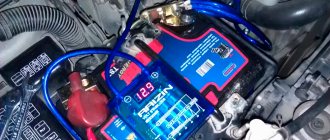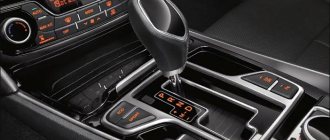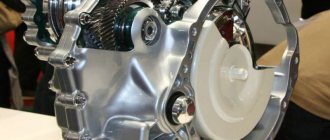At one time, the MPI engine was an important breakthrough in the automotive field. Now it is becoming a thing of the past, and not even all motorists remember about it and can give at least an approximate definition of this unit. The appearance of this engine made it possible to abandon carburetor units. If we consider the line of Volkswagen engines, then MPI is the oldest development, the use of which has been delayed for such a long period. For the last few years, such units have been installed only on Skoda. Despite the emergence and widespread use of new engines, MPI is still considered the most reliable, trouble-free and practical in the line of injection units.
Features of the MPI engine.
History of development and modernity of multi point injection engines
The engine design was first developed at the German Volkswagen plant. The prototype of MPI is the EA827 series engines, produced since 1972. Since 1994, the unit has been modernized by assigning the ADP index. In the process of further modernization, the diameter of the cylinders changed, the block material became aluminum, and the technical characteristics improved.
The production of MPI engines with the BSE index began in 2005. Almost all Wolfsburg cars were previously equipped with engines with this design.
After VAG acquired the Škoda business, the MPI engine was present in the cars of the Czech manufacturer.
Over time, as environmental requirements increased, the unit ceased to be in demand in Europe and was discontinued.
The last brand to install an MPI engine was the Skoda Octavia 2 series. But the designers were able to improve the transmission in accordance with the new emission standards and brought it to life.
Today the engines are produced at a plant in the German city of Chemnitz. They have been produced since 2014 with the index 1.6 MPI EA211 (110/90 horsepower) and are supplied to the Volkswagen car plant in Kaluga.
Where is it implemented?
Now you understand a little about what an MPI engine is. For the first time, such technology was successfully introduced into the Polo model. Later, the Golf and Jetta also received such engines.
Let us note that such engines are obsolete from the Volkswagen engine range. However, they are practical and trouble-free. Many experts argue that today such power plants do not meet modern standards of efficiency and ecology. In addition, quite recently one could say that the manufacturer stopped producing such motors. The last car to receive an MPI engine is the Skoda Octavia of the second series.
However, the technology has recently been revived and has become in demand. In the fall of 2015, the concern launched a production line for these engines at the Kaluga plant, where they began producing motors of the EA211 series.
Design features of the mpi engine
The base is an aluminum cylinder block with cast iron rings.
The absence of a turbocharger is another distinctive feature of MPI engines.
Unlike the TSI series, the design provides for the absence of a fuel rail. From the tank, the pump supplies gasoline to the injector through a dedicated channel. The Simos 7 control system injects gasoline through a nozzle into a plastic manifold under a pressure of about 3 atmospheres.
In it, based on the readings of the MAP sensor, a fuel-air mixture is created, which enters the cylinder through the intake valve and burns. The released energy moves the piston, which creates torque. The unit operates without a turbocharger.
The gas distribution mechanism has 8 valves, 2 per cylinder. There is no need to adjust the valve clearance. This is done using hydraulic lifts. Neutralization of gases is carried out by a catalyst, in front of which there is a lambda probe. The exhaust system has a built-in pump that supplies air to quickly heat the catalytic converter.
Design features determine the presence of the ignition advance function. As a result, the throttle has high sensitivity from the accelerator pedal.
The water cooling circuit ensures that the mechanism does not overheat. In the MerCruiser system, proper engine operation is stabilized by timely operation of the gas-air locks.
The unit is equipped with a special hydraulic control and a separate coupling with an integrated grease nipple. Rubber mounts automatically adapt to uneven road surfaces, speed, and speed, reducing vibration and noise.
Direct injection
Appeared not so long ago, in the 80s - 90s of the last century. Such brands as MERCEDES, VOLKSWAGEN, BMW, etc. were actively involved in development.
Abbreviation GDI (Gasoline Direct Injection) - injection directly into the combustion chamber
Injection occurs according to the phased type principle, that is, each nozzle is controlled separately. Often they are attached to a high-pressure rail (something like COMMON RAIL), but there are also separate elements, the fuel is suitable for each separately.
Engine versions 1.6 mpi
The Skoda Octavia a5 fl model was equipped with a 1.6 MPI BSE engine with a power of 102 hp. Currently, 1.6 MPI engines are available in 2 modifications:
- CWVB - 90 hp (66kW).
- CWVA with a power of 110 hp or 81 kW;
Skoda Octavia a5 fl is one of the most popular and widespread cars.
Skoda Octavia 2012 l. With. - just
Krasnoyarsk
Skoda Octavia, 2012
588 000 ₽
Irkutsk
Skoda Octavia, 2008
385 000 ₽
Dir
Skoda Octavia, 2011
360 000 ₽
Moscow
Skoda Octavia, 2012
525 000 ₽
See more cars on Drome
Participate in the discussion can only registered users.
Login Register
This is interesting: What engine is on the VAZ 2114
Technical characteristics of the 1.6 mpi engine
| Power | 110 hp |
| Workload | 1595 cm³ |
| Type of fuel | gasoline with an octane rating higher than 91 |
| Maximum speed | 195 kilometers per hour |
| Fuel consumption (city, highway, mixed) | 8.1 l per 100 km, 5.0, 6.3 |
| Torque/speed max Nm/min | 155 / 3800-4000 |
| Acceleration time to 100 km/h | 10.7 seconds |
| CO2 content (city, highway, mixed) | 187/117/142 |
| Environmental class | Euro 4 |
| Injection | distributed |
| Engine location | anterior, transverse |
| Compression ratio | 10,5: 1 |
| Cylinder diameter | 81.0 mm |
| Piston stroke | 77.4 mm |
| Cylinder order | 1-3-4-2 |
| Oil volume | 4.5 l |
| Resource | 250-300 thousand km |
Advantages of mpi engine
The modification was very popular among motorists. The engine has received many positive reviews as one of the most reliable in the Volkswagen Group lineup.
Simplicity of the device
Compared to the regular TSI version, the MPI does not have a turbocharger and a high-pressure fuel pump. A simple device reduces the cost of the car, repair and maintenance costs.
The simplicity of the mpi motor design allows you to save on its repair.
Undemanding requests for fuel quality
A car equipped with an MPI engine can be fueled with cheaper AI-92 gasoline. Provided that the oil and filters are changed in a timely manner, the engine can travel 300 thousand km without major repairs.
Minimum probability of overheating
During operation, the cylinder head becomes very hot, which can lead to the formation of a gas-air block, overheating and boiling.
The water cooling circuit of the fuel mixture prevents excessive heating.
Minuses
If you believe the reviews, MPI engines are less dynamic, and there is an explanation for this. Due to the fact that gasoline is mixed with air in the exhaust ports (before it is supplied to the cylinders), these engines are limited. Also, the eight-valve system with a timing belt makes it clear that the engine lacks power. Therefore, such engines are not designed for quick start and acceleration.
The second disadvantage is uneconomical. Multipoint injection is inferior in efficiency and economy to supercharging with direct fuel injection into the cylinders. As mentioned above, this technology is implemented in TSI engines.
Characteristic disadvantages of mpi
Along with positive reviews, users express many shortcomings of the engine identified during its operation.
High engine oil consumption
Excessive oil consumption is a common occurrence on CWVA. Retailers consider this the norm before entering the market. It takes up to 200-400 ml per 1000 km, which is a lot compared to other models.
it is possible that the high oil consumption is associated with the Castrol 5w-30 brand used. Therefore, it is recommended to check the oil level weekly.
The problem of engine oil consumption worries many motorists.
First steps.
An MPI program is a set of parallel interacting processes that each work in their own allocated memory area. Essentially, these are N independent programs that communicate with each other during operation. In MPI, most data types are already redefined and begin with the abbreviation MPI_[Name] , this will be clear later.
To understand what happens next, you need to define several terms:
A communicator is an object through which a certain group of generated processes communicates. In C++/C this is the MPI_Comm . A communicator can unite several processes by passing messages between them, while there can be several communicators; the groups they form can either not intersect or partially intersect. When the program starts, all processes work under a single communicator named MPI_COMM_WORLD . In addition to it, there are also communicators MPI_COMM_SELF , MPI_COMM_NULL , which contain only the current process and no processes, respectively.
A message is a set of data of some type that is transmitted during process communication. Each message has several attributes, such as the sending process number, the recipient process number, the message ID, the communicator, and the tag.
Message tag is a non-negative integer from 0 to 32767 (Depending on implementation. The maximum possible tag value is stored in the MPI_TAG_UB ).
In this example, we will not use data transfer, but will only familiarize ourselves with the basics of MPI procedures. To be able to use most MPI procedures, any program should have the following procedures:
int MPI_Init(int *argc, char ***argv); int MPI_Finalize(void);
The first procedure is intended to initialize the parallel part of the program; all other procedures, except for some special ones, can be called only after calling the MPI_Init procedure; this function accepts command line arguments, through which the system can pass some launch parameters to the process. The second procedure is intended to complete the parallel part of the program.
In order to check the operation of the program, we implement the most primitive program in C++ using MPI.
#include #include "mpi.h" int main(int argc, char **argv) { printf("Before MPI_INIT\n"); MPI_Init(&argc, &argv); printf("Parallel sect\n"); MPI_Finalize(); printf("After MPI_FINALIZE\n"); return 0; }
To run this program, let’s save our entry in a file with any name and extension *.cpp , then perform the following actions in the console (In my case, the code is in the main.cpp file):
[user-name]$ mpic++ main.cpp -o main [user-name]$ mpiexec -n 2 ./main
The first command will compile our MPI program, and the second command allows us to run it. Note that we are passing the -n 2 parameters on the second line, why is this necessary? Thus, we inform the executor that 2 parallel processes need to be launched.
The program will simply print a few lines depending on the number of processes you specify. Do not be alarmed if the lines “Before …” and “After …” are displayed more than once; depending on the MPI implementation, the program can work in parallel and outside the Init-Finalize procedures.











